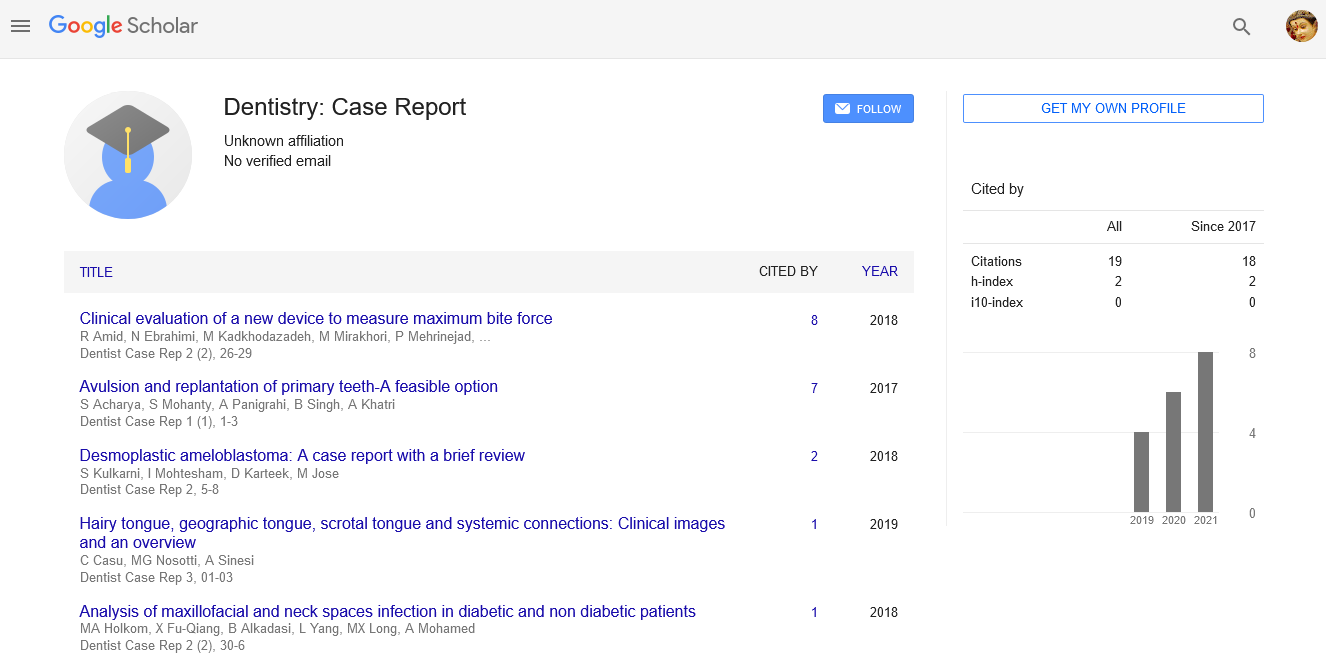Not everything is dental caries or periodontitis
Received: 11-Nov-2017 Accepted Date: Nov 20, 2017; Published: 25-Nov-2017
Citation: Sandra LV. Not everything is dental caries or periodontitis. Dentist Case Rep 2017;1(1):4.
This open-access article is distributed under the terms of the Creative Commons Attribution Non-Commercial License (CC BY-NC) (http://creativecommons.org/licenses/by-nc/4.0/), which permits reuse, distribution and reproduction of the article, provided that the original work is properly cited and the reuse is restricted to noncommercial purposes. For commercial reuse, contact reprints@pulsus.com
Editorial
In spite of the general health improvements that have taken place in order to achieve a longer life expectancy, diseases continue to appear in the oral cavity, which should be eradicated with technological and educational advances. At the very least, there should be a decrease in its prevalence, but on the contrary an increase of these is expected (1).
Oral health is not observed within the framework of felt morbidity (defined as what people say is a disease), either by the population or health professionals, because there are many myths around the oral diseases, example is that tooth loss can be caused by pregnancy or old age, popular beliefs that prevent the population seek dental care (2).
On the other hand, generally when “oral diseases” is mentioned, this expression seems to refer only to caries and periodontal disease; similarly, intervention projects in the area of dentistry have focused the most, as well as the exclusive detection of these two pathologies when and oral exploration is integrated as a component of the entire clinical exploration by physicians and/or nurses.
Apparently it has been forgotten that the oral cavity can present a variety of pathologies correlated with the same diversity of tissues that make up the stomatognathic apparatus and that even the present alterations can be a manifestation of some systemic disease or, on the contrary, pathologies of the mouth that can compromise other organs of the human body.
The consequences of these attitudes towards the neglect of the oral cavity in their care and the lack of knowledge on the part of specialists in mouth and other areas can be from a high morbidity in the population, a low quality of life in patients or even compromise life itself leading to death.
Clear example of this, are the malignancies that can be found in the oral cavity. It is not difficult to see faces of amazement when the patient is informed of a diagnosis of a malignancy, which in most cases is accompanied by the question: In the mouth?!. This demonstrates that unfortunately there is little emphasis in generating spaces for the diffusion of malignant entities in the oral cavity, due to the weak training that the dentist has, for the recognition of lesions beyond those that occur in the dental or periodontal organs. which triggers a limitation in the information for the patient, doctors, nurses or other health servers.
Moreover, the detachment in the recognition of lesions of the oral mucosa or bone tissues has been such that it is currently a trench between dermatologists and specialists in oral pathology.
The oral pathology has been defined from an epistemological sense by Eversoles as. “The specialized area of dentistry that deals with the diagnosis and management of oral diseases, except dental caries, periodontal disease, orthodontic therapy and restorative dentistry” (3).
Based on this meaning, around 600 diseases of different etiologies (genetic, autoimmune, infectious, benign or malignant neoplasms, etc.) have been documented and can be presented in the mouth, manifesting themselves in different clinical forms (4).
This opens a sea of diagnostic possibilities when observing a lesion in the mouth, which has induced studies in various countries, with the aim of knowing which the oral pathologies that occur most frequently are. However, the complexity of transporting these results to specific primary care clinics, lies primarily in the characteristics of their population (race, customs, culture, etc.), and secondly, the data obtained belong to specialized care clinics either in dermatology, histopathological laboratories or on the contrary they have not been corroborated with the biopsy.
Because the dentist, more than any other health professional has the possibility of observing, more frequently, the alterations that may occur in the mouth, said trench must disappear, but for this the dentist must show mastery in knowledge, detection and treatment through the publication of scientific documents.
REFERENCES
- Ramón-Martínez H, Marcos-Abdala H, Treviño E, et al. Application of nanotechonology in dentistry: Nano-Dentistry. Rev Ces Odont. 2011;24(2)87-91.
- Manski R, Magder L. Demographic and socioeconomic predictors of dental care utilization. J Am Dent Assoc. 1998;129:195-200.
- Eversole R. Evidence–based practice of oral pathology and oral medicine. CDA Journal. 2006;34(6):448-454.
- Axell T. A prevalence study of oral mucosal lesions in an adult Swedish population. Odontol Rev. 1976;27:1-103.





